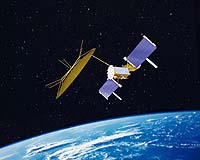 |
Sunnyvale CA (SPX) Mar 02, 2010 The U.S. Air Force's Defense Satellite Communications System (DSCS) B8 satellite, built by Lockheed Martin, has surpassed its 10-year design life of on-orbit service in providing secure and reliable communications capabilities for the warfighter. Launched from Cape Canaveral on Jan. 20, 2000, the B8 satellite is one of 14 DSCS III spacecraft designed and built by Lockheed Martin Space Systems for the MILSATCOM Systems Wing at the Air Force's Space and Missile Systems Center, Los Angeles Air Force Base, Calif. The satellite is also the first of four DSCS III satellites to feature Service Life Enhancement Program (SLEP) upgrades that enabled a 200-percent increase in communication capacity over original DSCS III spacecraft with its 50-watt Traveling Wave Tube Amplifiers. "The high performance and longevity of the DSCS III constellation is direct testimony to a joint U.S. Air Force/Lockheed Martin team dedicated to providing the warfighter with secure and reliable satellite communications," said Kevin Bilger, Lockheed Martin's vice president and general manager of Global Communications Systems. "The DSCS III constellation has provided the Department of Defense with its core communications capability for over two decades and will continue to make a significant contribution to our national security well into the future." The system provides uninterrupted secure voice and high-data rate communications to Department of Defense users; essential tools in monitoring events and deploying and sustaining forces anywhere in the world. In 2009, the overall DSCS III constellation surpassed 200 years of on-orbit operations, the longest total operational experience of any U.S. military communications satellite constellation. Lockheed Martin is also progressing on the Department of Defense's highly secure communications satellite system, the Advanced Extremely High Frequency (AEHF) program. As the successor to Milstar, AEHF will increase data rates by a factor of five, permitting transmission of more tactical military communications, such as real-time video, battlefield maps and targeting data. The first AEHF spacecraft has completed final testing and is planned for delivery to the Air Force in second quarter 2010.
Share This Article With Planet Earth
Related Links Lockheed Martin Read the latest in Military Space Communications Technology at SpaceWar.com
 Multi-Beam Antenna Integrated With First MUOS Satellite
Multi-Beam Antenna Integrated With First MUOS SatelliteSunnyvale CA (SPX) Feb 25, 2010 Employees at Lockheed Martin's facilities in Sunnyvale, Calif., inspect the first Mobile User Objective System (MUOS) satellite following the successful integration of the Multi Beam Antenna (MBA) with the spacecraft system module and core structure. Preparations are now underway to begin environmental testing of the fully integrated satellite, which will provide assured communications, in ... read more |
|
| The content herein, unless otherwise known to be public domain, are Copyright 1995-2010 - SpaceDaily. AFP and UPI Wire Stories are copyright Agence France-Presse and United Press International. ESA Portal Reports are copyright European Space Agency. All NASA sourced material is public domain. Additional copyrights may apply in whole or part to other bona fide parties. Advertising does not imply endorsement,agreement or approval of any opinions, statements or information provided by SpaceDaily on any Web page published or hosted by SpaceDaily. Privacy Statement |